You Can't Stop A Wave But You Can Surf-2

"A more prosperous way down would be to work at community scale"
Part Two
According to both Jimmy Carter and Kris De Decker, whom we quoted in Part One, we can only solve energy poverty and energy decadence if we manage to decouple human need satisfaction from energy intensive ‘need satisfiers.’
“By equating what is ‘required’ with what is ‘normal,’” write UK energy poverty researchers,
“…we actively support escalating expectations of need, which runs counter to objectives like those of reducing energy demand… To achieve demand reduction entails challenging embedded norms rather than following them.”
 |
"Energy services could be reduced (smaller TVs or lighter and slower cars, or less TV watching and car driving) or replaced by less energy-intensive ones (using a bicycle instead of a car, buying more fresh instead of frozen food, playing board games instead of watching television)."
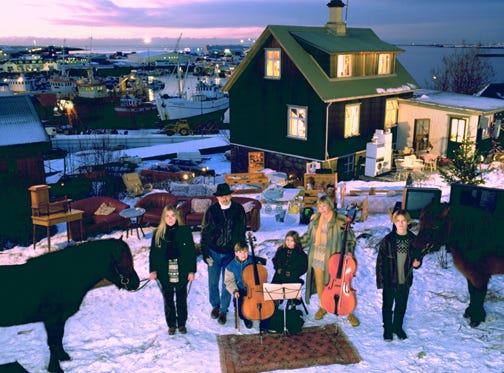 |
Combining sufficiency with efficiency measures, German researchers calculated that the typical electricity use of a two-person household could be lowered by 75%, without reverting to drastic lifestyle changes such as washing clothes by hand or generating power with exercise machines.
Although this only concerns a part of total energy demand, reducing electricity use in the household also leads to reductions in energy use for manufacturing and transportation.
A more prosperous way down would be to work at community scale: public transport, public bathing houses, community kitchens, bicycle kitchens, laundrettes, libraries, internet cafés, public telephone boxes, and food cooperative home delivery services.

This R2B2 kitchen unit by German designer Christoph Thetard (not for sale) combines three kitchen appliances with a central driving spindle. The heart of the unit is a treadle powered flywheel that works as short-term energy storage, capable of delivering up to 350 watts mechanical power to the appliances. Similar to late 19th century machines, and contrary to today’s kitchen devices, it is built to last.
If you need electricity for some important thing (such as torque to haul an Easter Island statue up from the quarry), throw a party. This is a beer powered 2 kW array.
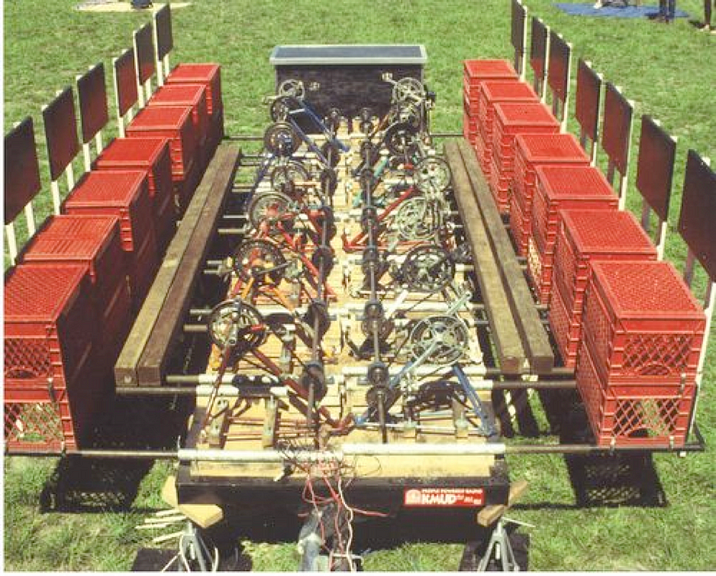
The pedal power that can be delivered by the average person over a sustained period of time was clocked in 1984 at 75 watts or 1 “hup” (human power). An average person can sustain one hup all day, 2 hups (150 watts) for roughly two hours, 3 hups (225 watts) for about 30 minutes and 4 hups (300 watts) only momentarily. Elite athletes have been known to hit 2000 hups in short bursts.
The average North American family (you too, Canada!) would need 14 of these running 24/7. It is no wonder the voters rejected Jimmy Carter’s message. If they followed the voluntary reduction path pledged by Obama in Paris they would still need 6 or 7 of them. The average Greek family (of 5) would need 1.4 of these running 24/7, or 3 running 12 hr per day. A family of 10 would need twice as many because the number is calculated on kWh per capita per country.
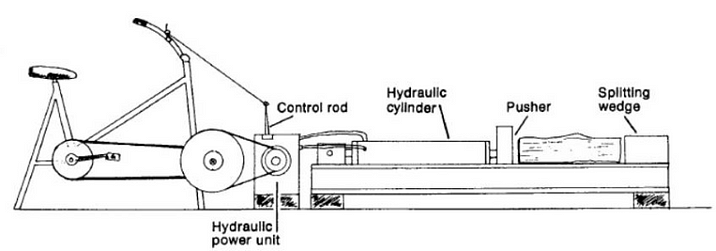
At present rates of emissions by 2020 there will only be 1000 gigatonnes left of the atmospheric parking space provided for carbon dioxide emissions for the remainder of the century. At 40 GtCO2 per year (present rate), that will be gone by 2045. If the world could cut emissions by half — an amazing feat — it would get us to 2070 before we lose the IPCC’s 66% bet of staying within an imagined non-catastrophic guardrail.
With each succeeding UN meeting it has become apparent that the only way we will stabilize climate and have a chance of returning to the comfortable Holocene where mammals with sweat glands are possible would be by deliberate removal of CO2 from the atmosphere by human intervention.
Because of how long CO2 naturally remains in the atmosphere, there is only a limited time, if any, to bend the curve before self-reinforcing tipping points take the situation beyond our control. Assuming we have not already passed that threshold, the longer we delay, the steeper the pitch must be on the descent.
From where we stand now, in 2018, to have a realistic chance of averting disaster, we need to reach an 11 percent decline rate per annum from 2036 (preventing catastrophic climate change above 2 degrees) or better, a 20 percent decline slope (limiting ourselves to dangerous climate change at around 1.5 degrees).
This type of curve will not be easily achieved. An 11 percent decline slope is the inverse of doubling your fossil economy every 7 years — so, halving every 7 years. Try to imagine half the numbers of commercial passenger flights in 2025 as today, or half the numbers of gas-powered engines. Half the numbers of WalMart SuperStores bringing full cargo ships from Shenzhen to Houston. Then halve that by 2032 and again by 2039. You get the picture.
If you imagine that renewables will surge to fill the gap, you really have a vivid imagination and should consider a career writing childrens’ stories.
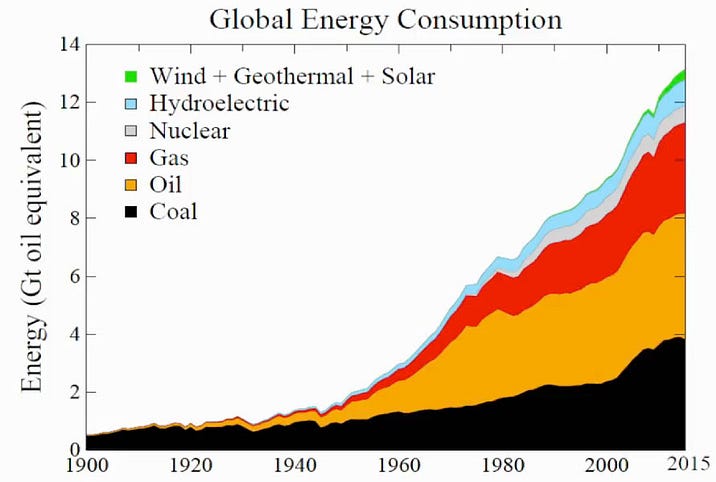 |
Avoided emissions will not be adequate. Even replacing fossil fuels with sunlight, wind, and firewood will not bring carbon back into the safety zone fast enough. In most scenarios renewables will only help to fill a growth gap in overall supply increases.
An international team of climate scientists, economists and energy systems modelers have built a range of new “Shared Socioeconomic Pathways” (SSPs) that examine how global society, demographics and economics might change over the next century.
These SSPs are now being used as scenarios for the latest climate models, feeding into the IPCC Sixth Assessment Report (AR6) due to be published in 2020–21. They are also being used to explore how societal choices will affect greenhouse gas emissions and, therefore, how the social inertia impeding the climate goals of the Paris Agreement could be overcome.
The SSPs are based on five narratives describing broad socioeconomic trends that could shape future society. These include one green economy approach and four variants of business as usual.
Here is how they predict the energy mix will play out through the remainder of this century. Each chart takes 2010 as the starting point, lining up nicely with that last image we used — of global energy consumption.
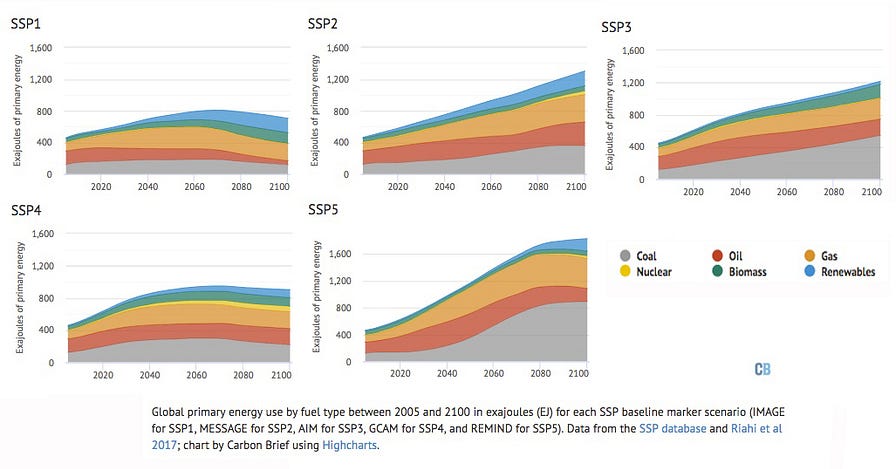
SSP1 takes the “Green Road.” Consumption is oriented toward low material growth and lower resource and energy intensity. This would be where everyone begins to live more like that family in the yurt. SSP2 is business as usual. The world follows a path in which social, economic, and technological trends do not shift markedly from historical patterns.
SSP3 is regional rivalry, where reaction to peak oil causes a reflexive turn towards violent tribalism and hoarding. Population growth is low in industrialized and high in developing countries, which creates migration pressures worldwide. Low international priority for addressing environmental concerns, coupled with rapid climate change, leads to strong environmental degradation in some regions.
SSP4 is exploitation of the poor by the rich. Over time, a gap widens between an internationally-connected society that contributes to knowledge- and capital-intensive sectors of the global economy, and a fragmented collection of lower-income, poorly educated societies that work in a labor intensive, low-tech economy. Investments in both carbon-intensive fuels like coal and unconventional oil, and also in low-carbon energy sources, keep wealth inequality growing.
SSP5 is Burning Man. There is a push for economic and social growth coupled with exploitation of abundant fossil fuel resources opened by new technologies and the adoption of resource and energy intensive lifestyles around the world. Bill Gates and Elon Musk invest in geoengineering.
It is difficult to find earthly biophysical support for these projections. In the green pathway (SSP1), emissions peak between 2040 and 2060 — even in the absence of specific climate policies, declining to around 22 to 48 gigatonnes of CO2 (GtCO2) per year by 2100. This results in 3–3.5°C of warming by 2100. All 5 pathways end in climate change that should be deemed unacceptable, and some would end higher order civilization. SSP5, the high-growth energy-intensive pathway, shows the most overall emissions of any SSP, ranging from 104 to 126 GtCO2 per year in 2100, resulting in warming of 4.7–5.1°C.
So those are your choices, friends. You can follow the path being laid out by IPCC and the United Nations and it marches you to the Gates of Hell. You can shortcut that process if you follow the path being laid out by the current administration of the United States or its right wing clones soon to follow in goosestep across Europe.
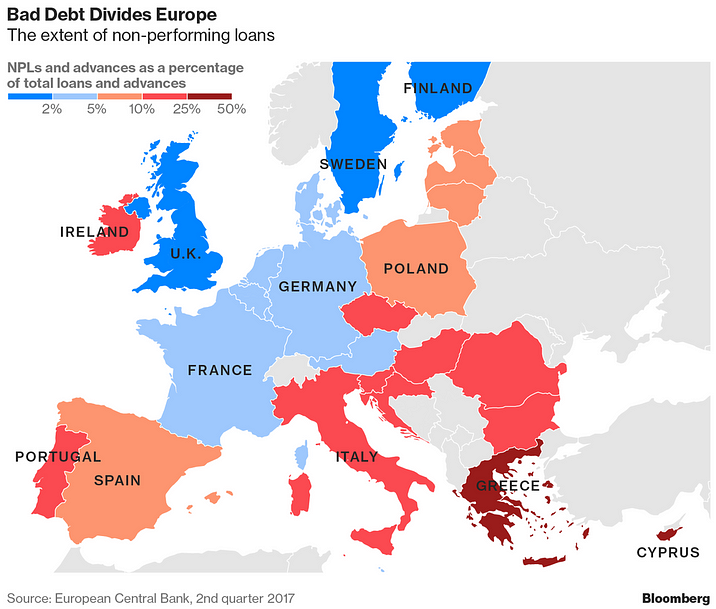
Or you could follow the path mapped by Jimmy Carter on April 18, 1977 and learn to surf. Ride the wave to the beach. Learn to live on less and do it with style and panache. One way or the other, living on less is in our common future.



Comments
I believe it is true that green plants have flourished in much warmer temperatures than +2-4 C. I also seem to remember that a plant which is photosynthesizing removes heat from the air. At any rate, a forest is definitely cooler than a Way-Mart parking lot. Might it be true that one essential for survival is to live in a forest? If so, planting one's own food forest would seem to be prudent.
Your thought appreciated....Don Stewart